
Published: 07/19/2023
In the modern landscape of defense and security, information superiority and situational awareness are paramount. Government agencies tasked with safeguarding national interests rely on robust Command, Control, Communications, Computers, Intelligence, Surveillance, and Reconnaissance (C4ISR) and Command, Control, Communications, Computers, Cyber, Intelligence, Surveillance, and Reconnaissance (C5ISR) systems. To ensure mission success, it is crucial to adopt best practices that maximize the effectiveness of these complex and interconnected systems. In this article, Elevated Technologies sheds light on the best practices for C4ISR and C5ISR in government use cases.
1. Integrated Systems and Interoperability:
The cornerstone of effective C4ISR and C5ISR implementation lies in integrating various systems into a cohesive network, ensuring sensors and software work cohesively to successfully execute the ISR mission. Government agencies should prioritize the development and adoption of interoperable systems that allow seamless data exchange, collaboration, and coordination across different platforms and domains. This facilitates real-time decision-making, enhances information sharing, and enables a comprehensive and unified operational picture.
2. Cybersecurity and Resilience:
In the face of evolving cyber threats, safeguarding critical information and systems is vital. Government agencies must implement robust cybersecurity measures to protect C4ISR and C5ISR systems from unauthorized access, data breaches, and disruptions. This includes proactive monitoring, threat intelligence, encryption, access controls, and continuous vulnerability assessments. Building resilience into these systems through redundancy, backup capabilities, and rapid response protocols ensures continuity of operations even in the face of cyberattacks.
3. Scalability and Flexibility:
Government missions evolve and expand over time, requiring C4ISR and C5ISR systems that can scale accordingly. Implementing scalable and flexible architectures allows government agencies to adapt to changing requirements, integrate new technologies, and accommodate growing volumes of data. By embracing modular and open standards-based solutions, agencies can ensure the agility and future-readiness of their systems, enabling seamless upgrades and the incorporation of emerging capabilities.
4. Data Fusion and Analytics:
C4ISR and C5ISR systems generate vast amounts of data from diverse sources. To derive actionable insights and support informed decision-making, government agencies should employ advanced data fusion and analytics techniques. By integrating data from multiple sensors, platforms, and intelligence sources, agencies can gain a comprehensive understanding of the operational environment. Applying analytics and machine learning algorithms enables the extraction of valuable patterns, trends, and anomalies, empowering agencies to anticipate threats, identify opportunities, and optimize resource allocation.
5. Training and Human Factors:
While technology plays a critical role, the human element remains fundamental in C4ISR and C5ISR operations. Government agencies can invest in comprehensive training programs to equip personnel with the necessary skills to effectively utilize and leverage these complex systems. Training should encompass system operation, data analysis, decision-making, and cyber hygiene. Additionally, a strong focus on human factors, such as user interface design, ergonomics, and cognitive workload management, ensures optimal user experience and performance.
6. Continuous Innovation and Collaboration:
The landscape of defense and security is ever evolving, demanding continuous innovation and collaboration. Government agencies should foster partnerships with industry leaders, research institutions, and other government entities to leverage emerging technologies, share best practices, and stay at the forefront of advancements in C4ISR and C5ISR. Embracing a culture of innovation and collaboration enables agencies to harness the latest capabilities, optimize mission effectiveness, and maintain technological superiority.
Implementing best practices for C4ISR and C5ISR is vital for government agencies to achieve information superiority and operational effectiveness. Elevated Technologies understands the unique challenges faced by government use cases and provides tailored solutions for ISR programs including training product development, technical documentation, IT, and field support. By integrating systems, prioritizing cybersecurity, embracing scalability, harnessing data fusion and analytics, and investing in training and collaboration, government agencies can optimize mission success and uphold national security in an increasingly complex world.
